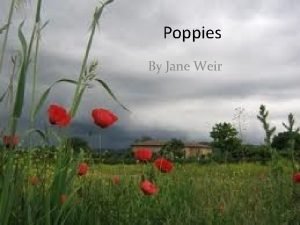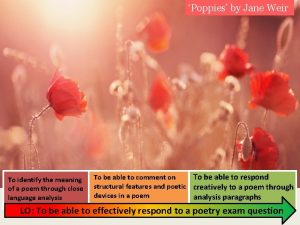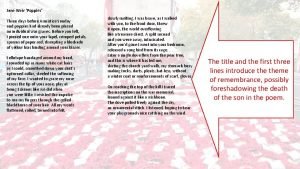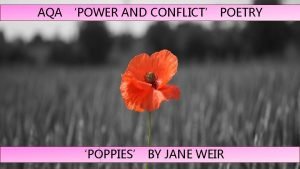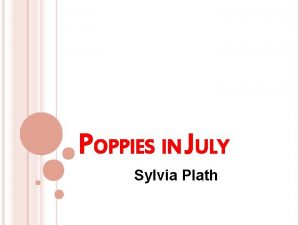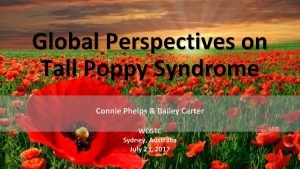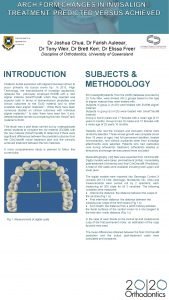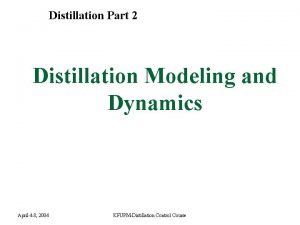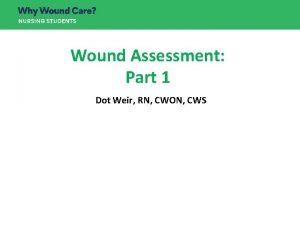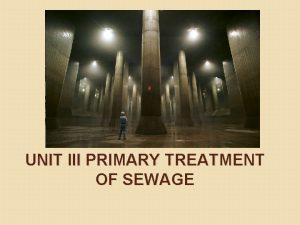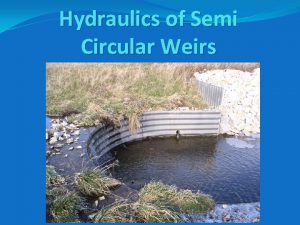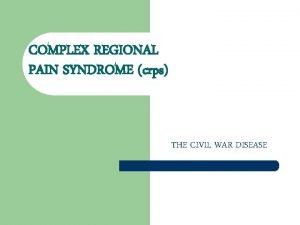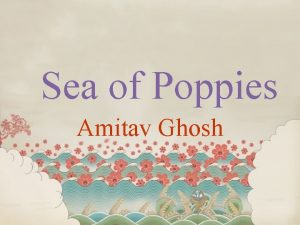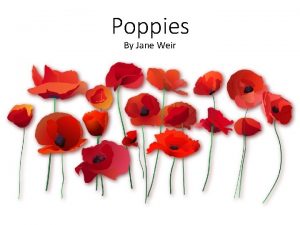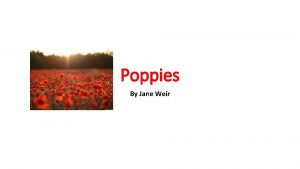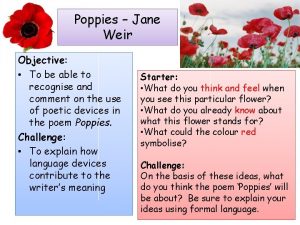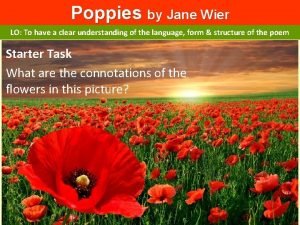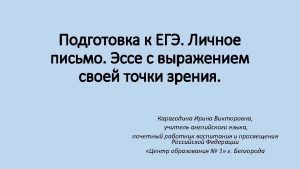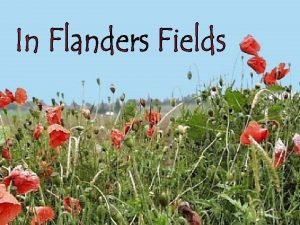Poppies Jane Weir Learning aims To evaluate how
















- Slides: 16

Poppies- Jane Weir

Learning aims: To evaluate how the poem links to power and conflict To analyse the language and structure used in the poem To understand the context of Poppies.

New knowledge: To understand the context of Poppies. Poet: Jane Weir • Lived in Northern Ireland during the 1980’s. • Owns a textile business. • Comes from a collection called ‘Exit Wounds’ put together by Carol Ann-Duffy, helping people understand the suffering caused by loss. • Mother of two teenaged boys. • Her poem is heavily based on the idea of poppies as symbols of memory and how today they remember victims of war. • Themes: Effects of conflict, Loss and Absence, Memory, Fear, Individual Loss.

New knowledge: “Poppies” is a poem that uses dense imagery to portray a mother’s feelings towards her son, and to explore the devastating consequences of conflict beyond the battlefield. To understand the context of Poppies.

New knowledge: "I wanted to write a poem from the point of view of a mother and her relationship with her son, a child who was loved cherished and protected… and it had led to this…. heightened and absolute fear that parents experience in letting their children go, the anxiety and ultimately the pain of loss… I hoped to somehow channel all this, convey it into something concise and contemporary, but also historically classic, in terms of universal experience. " To understand the context of Poppies.

Develop: Poppies To analyse the language and structure used in the poem Take a couple of minutes to read through the poem yourself: Three days before Armistice Sunday and poppies had already been placed on individual war graves. Before you left, I pinned one onto your lapel, crimped petals, spasms of paper red, disrupting a blockade of yellow bias binding around your blazer. Sellotape bandaged around my hand, I rounded up as many white cat hairs as I could, smoothed down your shirt’s upturned collar, steeled the softening of my face. I wanted to graze my nose across the tip of your nose, play at being Eskimos like we did when you were little. I resisted the impulse to run my fingers through the gelled blackthorns of your hair. All my words flattened, rolled, turned into felt, slowly melting. I was brave, as I walked with you, to the front door, threw it open, the world overflowing like a treasure chest. A split second and you were away, intoxicated. After you’d gone I went into your bedroom, released a song bird from its cage. Later a single dove flew from the pear tree, and this is where it has led me, skirting the church yard walls, my stomach busy making tucks, darts, pleats, hat-less, without a winter coat or reinforcements of scarf, gloves. On reaching the top of the hill I traced the inscriptions on the war memorial, leaned against it like a wishbone. The dove pulled freely against the sky, an ornamental stitch. I listened, hoping to hear your playground voice catching on the wind.

To analyse the language and structure used in the poem Develop: Enjambment § § § Could raise ideas about how most children make a break from their parents. To emphasise their separation – mother is ‘cut off. ’ Could help to reflect the idea that loss has left the mother feeling emotionally broken. Written as a monologue in 4 stanzas and no rhyme scheme. The stanzas are structured along events in the life of mother and child. Pronouns “I” and “Your” used to emphasises the intimacy and closely of the speaker and subject Symbolism: The poppy has symbolic links to violence, death and memory. It is quite foreboding in this poem. Imagery is an ominous reminder that war… –Separates people –Divides people –Kills people. Symbolises the son’s identity as a soldier. Symbolises the danger he is in. Three days before Armistice Sunday and poppies had already been placed on individual war graves. Before you left, I pinned one onto your lapel, crimped petals, spasms of paper red, disrupting a blockade of yellow bias binding around your blazer.

Develop: To analyse the language and structure used in the poem Familiar noun/military metaphor The reference to sellotape is quite a familiar homely image, ‘bandaged’ can be used to imply wound or injury/harm. Sibilance, The words ‘steeled, shirt, softening’ etc. gives a calm tone to the scene described in the poem. Sellotape bandaged around my hand, I rounded up as many white cat hairs as I could, smoothed down your shirt’s upturned collar, steeled the softening of my face. I wanted to graze my nose across the tip of your nose, play at being Eskimos like we did when you were little. I resisted the impulse to run my fingers through the gelled blackthorns of your hair. All my words flattened, rolled, turned into felt, Aside, the personal anecdote creates a sense of intimacy and human realism in the speakers voice. Juxtaposed with the military side of her son References to the sense of touch shows how the mother longs for closeness. Suggests she’s struggling to cope with loss. “blackthorns” allude to Jesus, hinting at the sacrifices her son may make. Reminds that good memories can be painful. Power of three, reflects the way the mother is tongue tied and doesn't know what to say, she is proud of her son but also doesn't want him to go.

To analyse the language and structure used in the poem Develop: Simile, suggests how attractive the world appears to her son and also her aspiration for him to have opportunities. Visual image in symbolic. Symbol of peace – the son’s motivation for joining the armed forces? Symbol of mourning – is the son dead? What other evidence could support this idea? Metaphor, connotes that he is like a beautiful caged creature and needs to be set free. Implies that she understands this includes free to make mistakes and be harmed slowly melting. I was brave, as I walked with you, to the front door, threw it open, the world overflowing like a treasure chest. A split second and you were away, intoxicated. After you’d gone I went into your bedroom, released a song bird from its cage. Later a single dove flew from the pear tree, and this is where it has led me, skirting the church yard walls, my stomach busy making tucks, darts, pleats, hat-less, without a winter coat or reinforcements of scarf, gloves. Like any mother, she is fearful for son’s safety. Having to accept a person’s choices can be very difficult to bear. Irony – it’s usually the soldier who is “brave”, so this highlights the poet’s focus on other victims of conflict. Another word for ‘drunk, ’ implying lack of control. The mother has no control over what happens to her son. Another word for ‘wrecked, ’ hinting that the son’s decision is destroying the mother. Might he effectively wreck his own life? Listing, implies the awkward feeling of the mother, trying to distract herself from grief.

To analyse the language and structure used in the poem Develop: Physical senses, implies the intimacy between mother and son, connotes the tactile hypersensitivity and jumbled emotions Caesura, breaking down the verses, implies the choking back tears. On reaching the top of the hill I traced the inscriptions on the war memorial, leaned against it like a wishbone. The dove pulled freely against the sky, an ornamental stitch. I listened, hoping to hear your playground voice catching on the wind. Simile creates a strong visual image of the mother leaning against something that represents her son. Leaning is a sign of her wanting to connect. Wishbone shape symbolises hope. Being able to sense the son’s presence is very important to the mother – it’s her coping strategy. She desperately seeks reassurance. A poignant reminder that some mothers say ‘goodbye’ to their sons and never see them again.

Consolidate: To evaluate how the poem links to power and conflict How does the poem ‘Poppies’ link to power and conflict? Apply your analysis skills to individually analyse the rest of the poem using the questions on the following slides to help you.

ANALYSING ‘POPPIES’ What is the tone of this first stanza and how is it established in the opening line? Highlight all the examples of the caesura in the poem. The speaker is the mother of a son who has gone to war. Why has the poet used caesura? ‘Spasms’, ‘disrupting’ and ‘blockade’ are negative word choices. Why has the poet used them? What could they symbolise? Why does the mother pin the poppy on her son? Why does the son not do it himself? Three days before Armistice Sunday and poppies had already been placed on individual war graves. Before you left, I pinned one onto your lapel, crimped petals, spasms of paper red, disrupting a blockade of yellow bias binding around your blazer. The time frame of the poem is ambiguous. It’s not certain when exactly these events are taking place. Is this a mother sending her son off to the army or off to school? Why create this uncertainty? Why does the poet specify ‘individual war graves’? What are the connotations of a ‘blazer’? How is the poet trying to present the speaker’s son at this point? How does the speaker view her child? ‘Bias’, in this context, is a direction diagonal to a weave of fabric. (A slant). Highlight all the references to fabric and textiles in the entire poem. Why include these?

ANALYSING ‘POPPIES’ The speaker is trying to remember a tender moment with her son. How does ‘bandaged’ destroy this positive image? What does ‘steeled the softening of my face’ imply about the speaker’s emotional state? Why does the poet use enjambment? What is the effect and what does it suggest about the speaker? What device has been used in ‘blackthorns of your hair’? What are the connotations of this phrase? Sellotape bandaged around my hand, I rounded up as many white cat hairs as I could, smoothed down your shirt’s upturned collar, steeled the softening of my face. I wanted to graze my nose across the tip of your nose, play at being Eskimos like we did when you were little. I resisted the impulse to run my fingers through the gelled blackthorns of your hair. All my words flattened, rolled, turned into felt, Why does the speaker wish for the child to play at ‘Eskimos’ in this stanza? Where does the conflict appear in this stanza? Highlight and explain as annotations around your copy of the poem. What is happening to the speaker’s words in the final line? What does this mean?

ANALYSING ‘POPPIES’ ‘… the world overflowing like a treasure chest’ – What device is used here and how does the speaker’s son view this world? What type of word is ‘intoxicated’? What has the world done to the speaker’s son? What are the connotations of ‘intoxicated’? Why does the speaker place a full stop after this word? Do you think there is really a ‘song bird’ in the boy’s bedroom? What could this be symbolic of? What does the verb ‘threw’ imply about the speaker? slowly melting. I was brave, as I walked with you, to the front door, threw it open, the world overflowing like a treasure chest. A split second and you were away, intoxicated. After you’d gone I went into your bedroom, released a song bird from its cage. Later a single dove flew from the pear tree, and this is where it has led me, skirting the church yard walls, my stomach busy making tucks, darts, pleats, hat-less, without a winter coat or reinforcements of scarf, gloves. What do doves represent? There are more references to fabric in this stanza. Why include them? How could they be seen as metaphorical? Why do you think this stanza is slightly longer than the others?

ANALYSING ‘POPPIES’ Highlight the simile in this stanza. Discuss its significance. Why do you think the dove has led her to the memorial? What is the purpose of the dove? Consider the final two lines of the poem. What is the mother really hoping for here? What are the connotations of a ‘playground voice’? On reaching the top of the hill I traced the inscriptions on the war memorial, leaned against it like a wishbone. The dove pulled freely against the sky, an ornamental stitch. I listened, hoping to hear your playground voice catching on the wind. Can you use the following GRADE 7+ vocabulary in your annotations? How are themes of grief and loss explored in the poem? ‘Poppies’ is an ELEGY. What does this mean and why has the poet decided to write the poem in this way? Do you think her son is dead or alive? Be prepared to explain your ideas. Elegy: A poem of serious reflection, typically a lament for the dead. Lament: A passionate expression of grief and sorrow.

Review Which other poems in the anthology could you link to Poppies and why?
 Jane weir poet
Jane weir poet Sea poppies analysis
Sea poppies analysis My stomach busy making tucks darts pleats
My stomach busy making tucks darts pleats Context of poppies
Context of poppies Sylvia plath poppies
Sylvia plath poppies Connie carter
Connie carter Tony weir orthodontist
Tony weir orthodontist Dynamics
Dynamics Advantages of cipoletti weir
Advantages of cipoletti weir Exudate meaning
Exudate meaning Proportional weir in grit chamber
Proportional weir in grit chamber Semi circular weir
Semi circular weir Silas weir mitchell back injury
Silas weir mitchell back injury Why do we wear poppies
Why do we wear poppies Sylvia plath poppies in july
Sylvia plath poppies in july Benjamin burnham sea of poppies
Benjamin burnham sea of poppies Poppies in july
Poppies in july
